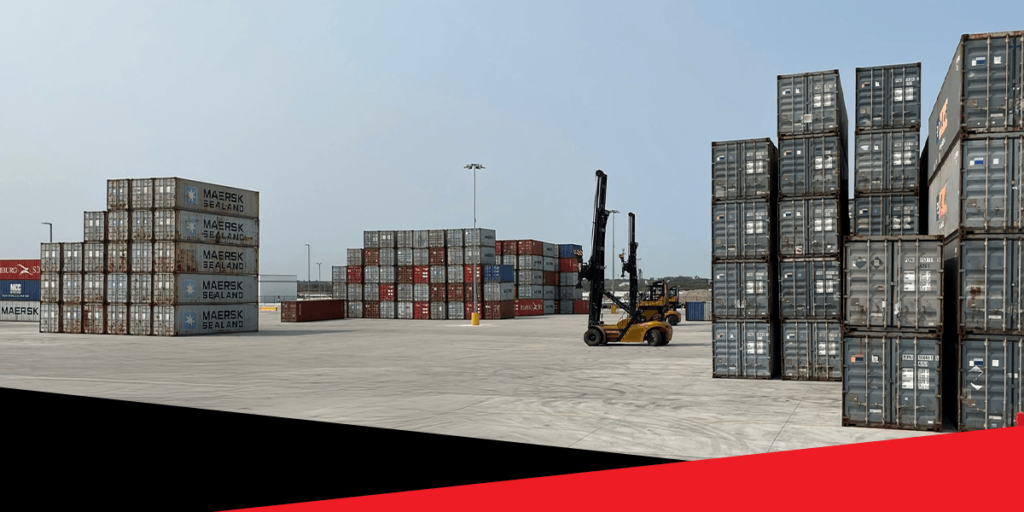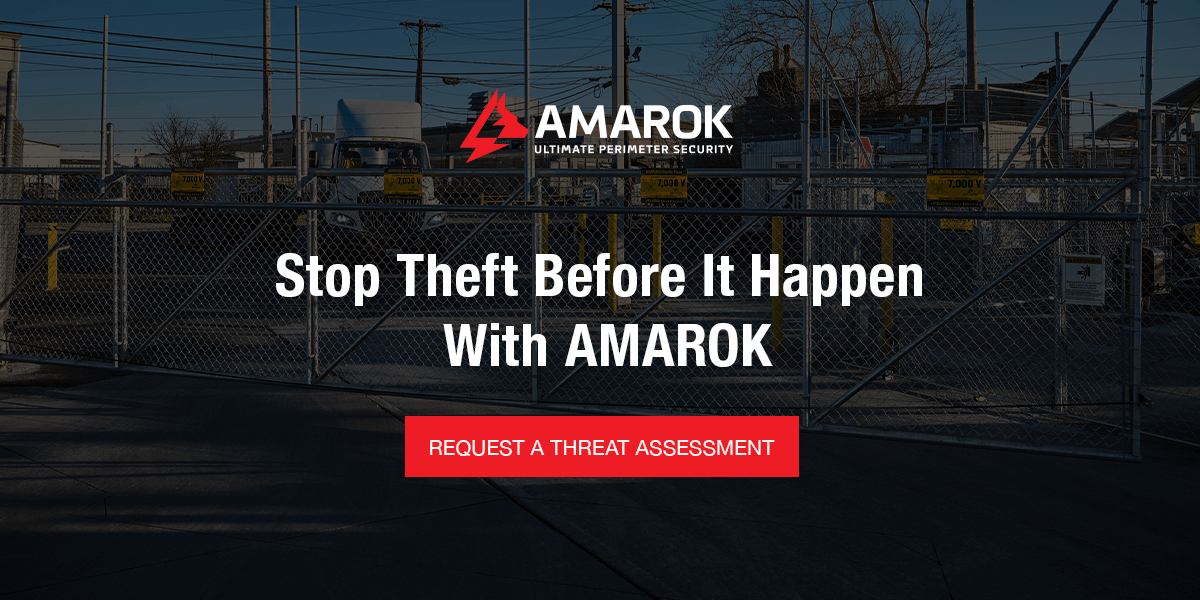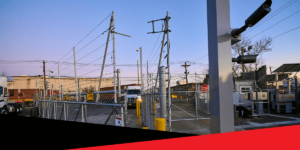Supply chain and cargo theft are among the top theft trends for 2025. Shipping containers are most vulnerable when stationary. Safe ports and container yards are the cornerstones of a prosperous economy, yet they face significant security challenges.
There were 1,183 reported cargo thefts in 2023, each averaging a loss of $586,917. These thefts are a consequence of criminals becoming increasingly creative, so businesses must have robust security solutions to protect their assets.
The Impact of Port and Container Yard Theft
In the third quarter of 2024 alone, 776 recorded cargo thefts occurred across the U.S. and Canada. These thefts are up 14% compared to the third quarter of 2023, and the total value of stolen goods exceeded $39 million. Criminal activity across any stage of the supply chain has a ripple effect if those challenges remain unaddressed.
Electronics, food, and beverages are the top targeted commodities. However, thieves can also sell many other items on the resell market, including auto parts and fuel. Supply chain delays can leave these items sitting at ports and container yards for extended periods. Thieves are getting smarter at identifying these delays.
The consequences of theft in ports and container yards include:
Economic Impact
Stolen cargo in the supply chain is a billion-dollar business. Theft of containers, cargo, and equipment results in substantial financial losses for shipping companies, port operators, and cargo owners. In addition to the direct financial impact of replacing stolen goods, thefts have the following economic consequences:
- Increased insurance costs: If you experience theft, your business will often face increased insurance premiums. Sometimes, your insurer might impose stricter management conditions, which can increase your operating costs. Repeated incidents could mean your insurer drops you altogether.
- Legal costs: If negligence or inadequate port security measures are involved, you could face legal consequences and insurance cancellation.
- Supply chain disruptions: Theft disrupts the entire supply chain. It causes delays in the delivery of goods, which leads to penalties for late shipments and loss of contracts.
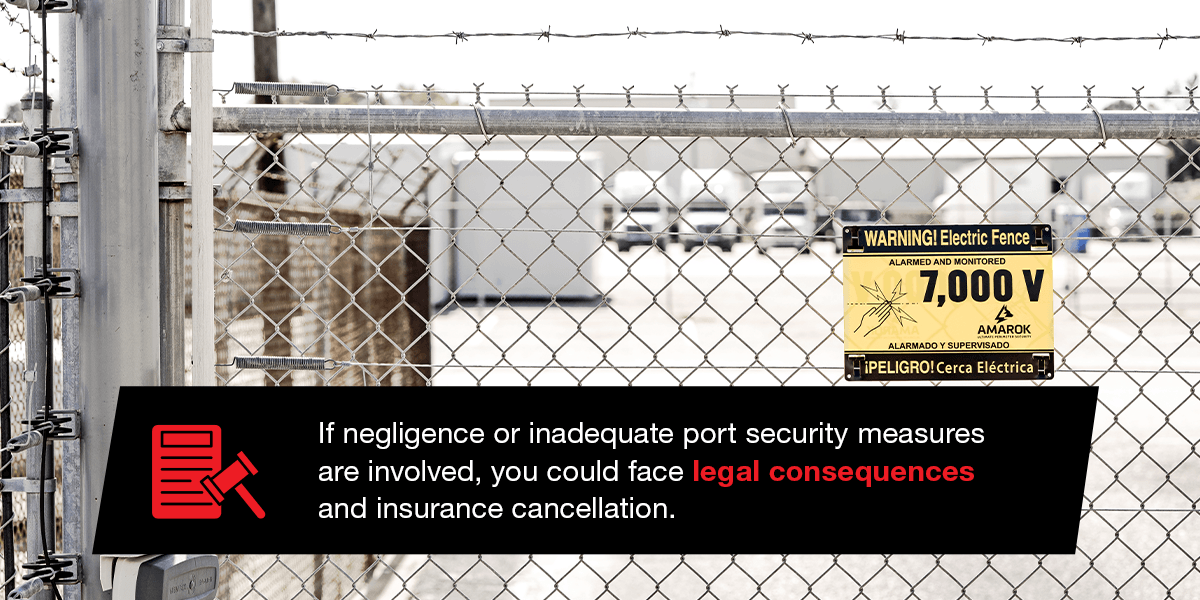
Reputational Impact
Repeated theft causes significant reputational damage, and your supply chain partners will lose trust in you. Your customers may look for providers with better security, which can have devastating consequences for your business. In addition, your brand reputation suffers, making it challenging to attract new customers.
Safety and Security Impacts
Once criminals have targeted your property, you’ll likely experience multiple theft attempts. The entire area may experience increased criminal activity, making the environment unsafe for your employees and visitors. These incidents can also escalate to violence, putting your personnel at risk.
Additionally, ports and container yards are already targets for organized crime syndicates, which pose a significant threat.
Common Threats to Ports and Cargo Areas
Several threats exist to port and maritime security. Protecting access points on oceans, seas, and rivers requires extensive collaboration and strategic planning. These infrastructures are critical to the economy and vulnerable to security threats like theft, vandalism, and terrorism.
Some of the top container yard and port security risks include:
Theft and Vandalism
Ports and container yards are full of people and have many moving parts, making controlling access a significant challenge. Criminals rely on easy entry to commit theft, sabotage, and other crimes. Ports are among the most challenging spaces to secure. They have multiple entry points, cover large areas, and are constantly busy, making it much easier for criminals to operate undetected.
In addition to having a large area to secure, many of these facilities operate 24/7, which requires comprehensive video surveillance. All security measures must be constructed to create minimal operational hurdles, as moving cargo must happen quickly. Large, unattended containers in these spaces are prime targets for opportunistic thieves. They use several methods to acquire cargo, including showing fake documentation to gain access to sensitive areas.
Organized Crime
One of the primary drivers of cargo theft is organized crime groups that specialize in these activities. Their techniques are increasingly sophisticated and often include document fraud and identity theft. Many pose as legitimate workers, using their false identities to steal the property they are meant to transport.
These organized crime groups sometimes employ sophisticated phishing schemes to access carriers’ official email accounts. They use these accounts to bid on shipments and bypass compliance checks. Upon stealing a part or a whole shipment, they switch license plates and identification to foil vehicle inspections. Many arrange multiple pickups over several days, obtaining as many loads as possible before the authorities catch on to their activities.
Smuggling and Terrorism
The transportation of illegal items like drugs, weapons, and counterfeit goods often relies on legitimate ports. These activities strain border protection efforts, and the economic significance of ports and container yards makes them attractive targets for terrorists looking to disrupt trade.
Cargo areas and ports are spread out over large properties, providing plenty of places to hide after an attack. Multiple trucks come in and out, allowing terrorists to move people and weapons without detection. Terrorist organizations can also use ports and container yards to smuggle illegal goods across borders.
Insider Threats
Ports and container yards employ many people, including workers, contractors, and other service providers. These people are potential insider threats. Whether accidentally or intentionally, they can leak information that compromises your security. Disgruntled or opportunistic employees also present a significant threat. They have legitimate authorization and access to your systems, which they can use to commit crimes or aid other criminals.
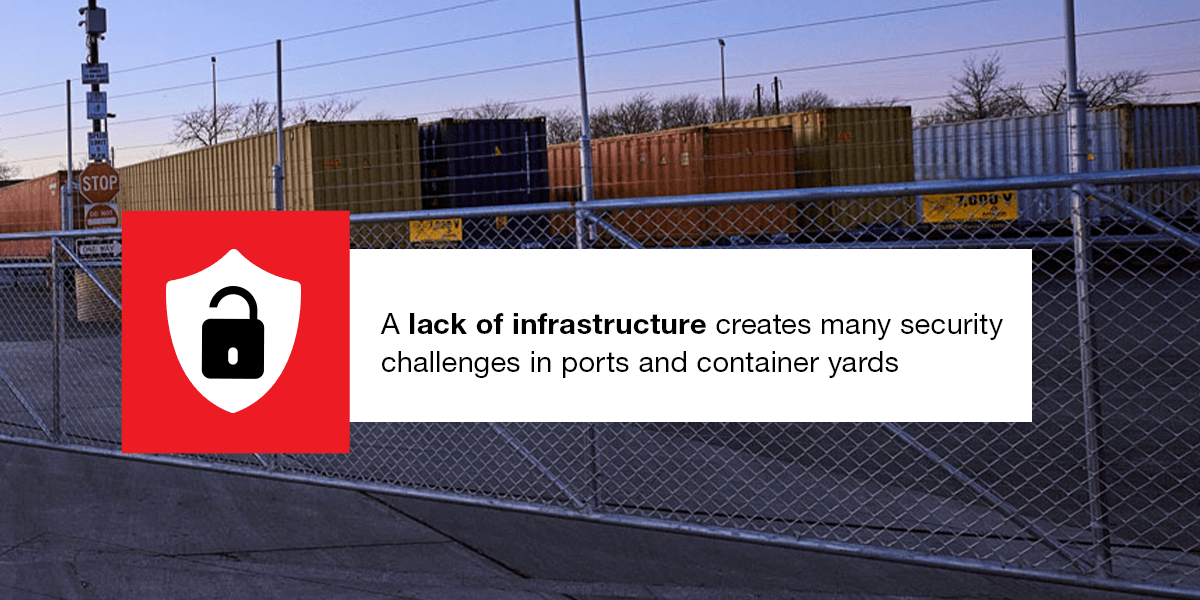
8 Tips for Boosting Your Port and Container Yard Security
A lack of infrastructure creates many security challenges in ports and container yards. Any neglect in port management or insufficient investments in physical security could have significant consequences. Inadequate maintenance of existing security infrastructure is another concern.
Fortunately, there are proactive steps you can take to secure your property against these significant and varied threats, including:
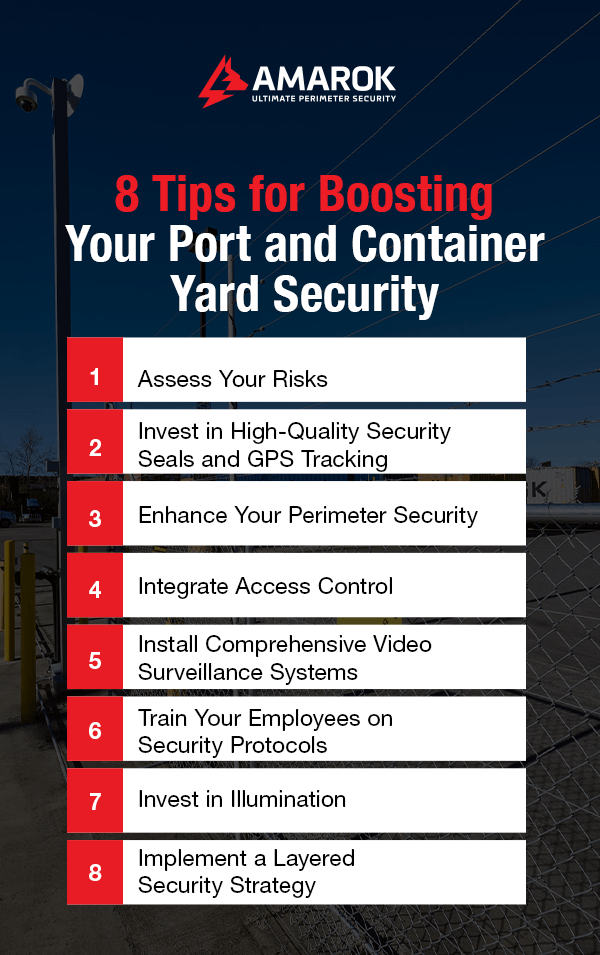
1. Assess Your Risks
The first step to enhancing physical security is identifying and prioritizing risks. Conducting a thorough evaluation of your security infrastructure helps uncover and address any weak points. To do this, it’s best to hire experienced security professionals to perform a threat assessment. They will give you the best possible understanding of your security posture in relation to the current threat landscape.
Your assessment will provide valuable information on internal risks like theft, your security infrastructure, and weak points in your workflow. Your security team will also consider external threats. They’ll examine local crime data to identify any direct physical dangers to your facility. From there, they will provide a comprehensive security plan that meets your unique needs.
2. Invest in High-Quality Security Seals and GPS Tracking
Ensuring cargo security during transit and storage is essential. High-quality seals made of durable materials can prevent opportunistic criminals from acquiring a container’s contents. Seals with unique identification numbers or barcodes can also be used for easy tracking and identification.
However, while seals create a reliable first line of defense, more is needed. Today’s criminals can compromise container seals and locks through brute force and tampering techniques, so these tools yield much better results when used with other security strategies, such as GPS tracking.
Many companies and transportation methods make up the supply chain, so pinpointing where a security issue occurred can make all the difference. GPS devices provide the cargo supplier with knowledge of where their assets are at any given time, giving them greater visibility and control. They also provide valuable location data for recovering missing items.
3. Enhance Your Perimeter Security
Perimeter security is both a deterrent and a physical barrier, enforcing the area’s boundaries. It’s the primary defense against unauthorized entry, but a chainlink fence alone isn’t enough in today’s threat landscape. Many ports and container yards are adding an electric perimeter fence inside their existing fence, which creates a more effective barrier between their assets and would-be criminals.
A high-quality electric security fence is the first proactive step in a layered security approach. Opportunistic thieves looking for an easy target will quickly move on when faced with such a formidable boundary. The most effective electric fences run on solar power, providing protection even when the electricity goes out. They are the backbone of your physical security and are compatible with multiple security enhancements.
4. Integrate Access Control
One of the most challenging aspects of port and container yard security is managing the large number of entry and exit points. Controlling access to these zones is a fundamental security element at these facilities. Access control systems encompass various technologies to help you monitor movements on your property and keep unauthorized people out. They even limit access to authorized personnel by role to maintain high-security spaces.
Like many other security strategies, access control is only a partial solution. It works best alongside an effective and intimidating barrier. For the best results, you can use a combination of physical and digital access control measures, including:
- Physical barriers: Gateways, turnstiles, and bollards are effective deterrents that allow you to control movements in and out of your facility. You can also use physical barriers inside your property to restrict movement through certain areas.
- Electronic access control: Access control is vital to your security but should serve its purpose without impacting workflows. Key cards and scanners allow authorized personnel to move freely while restricting the movements of unauthorized parties. You can update these systems whenever needed to account for role or employment changes.
- Role-based access control (RBAC): With employees, contractors, visitors, and transport services constantly moving through your property, it’s easy to lose track. RBAC allows you to restrict access by role. For example, you can prevent transport services from entering certain zones while granting access to trusted employees.
- Identification tools: You can only implement RBAC if your staff and visitors can identify themselves. Identification tools like PINs, credential readers, and key fobs can streamline entry. They also help maintain accurate entry and exit records.
5. Install Comprehensive Video Surveillance Systems
Strategically placed surveillance cameras provide comprehensive coverage of critical areas, including access points and high-value zones. These cameras act as yet another effective deterrent. When criminals know they are being watched, they rightfully assume they have higher chances of getting caught. You can run your video surveillance constantly or set it up to record when an alarm is triggered.
You can back up your video surveillance footage to the cloud or share it with law enforcement in real time. Doing so will expedite a response when police require video proof before responding to an incident. You can also use closed-circuit television (CCTV) cameras on your interior and exterior. They allow security personnel to watch live feeds on monitors. CCTV helps you monitor daily operations to maintain a safe space for your employees and visitors.
6. Train Your Employees on Security Protocols
Continuous port and container yard security programs create a security culture throughout your organization. Educate your employees on recognizing suspicious activity and responding appropriately. Implement a straightforward process for reporting transgressions so your team feels comfortable reporting concerns. You can also conduct regular drills and emergency simulations so that everyone understands their responsibilities in an emergency.
7. Invest in Illumination
Criminals often strike in the dark. They seek out poorly lit spaces along your perimeter and inside your property to conceal their activities. Well-placed lighting along your perimeter, access points, parking lots, and dark areas inside your property is an effective deterrent, as it gives thieves no place to hide. Motion-activated lights can be particularly effective because they illuminate intruders immediately and signal the activities to your security team.
Adequate lighting also makes video surveillance more effective inside and outside your facility by making it easier to identify criminal activity. Plus, these lights establish a feeling of safety and security, giving your employees greater peace of mind.
8. Implement a Layered Security Strategy
A single security solution is far from enough to combat today’s criminals. Combining multiple security measures provides a more robust defense against opportunistic thieves and vandals. A layered security approach ensures that if one system fails, others will protect your staff and assets.
Layered security operates with four primary goals — detect, deter, respond, and mitigate. You can enhance your overall security by adding the following layers:
- 24/7 remote video monitoring: With remote video monitoring, you can review video surveillance footage from anywhere. Stay proactive with cloud-based software and a mobile application for reviewing live feeds or recorded footage.
- Enhanced perimeter security: Install an electric fence inside your perimeter fence for an added deterrent. In the unlikely case that the warning signs don’t frighten off a would-be thief, they’ll receive a safe but memorable pulsed shock to deter further attempts at a breach.
- Alarm-based security lights: An alarm-based security light system detects movement along your perimeter when the electric fence alarm is activated. Once detected, the alarm activates the lighting, illuminating the intruder and alerting security personnel.
Stop Theft Before It Happens With AMAROK
If theft or vandalism occurs at your port or container yard, it can have catastrophic consequences. As criminals become more effective at committing crimes, robust security is crucial to protecting your assets, staff, and reputation. With AMAROK, you can detect and deter criminals, stopping theft before it happens.
AMAROK is an award-winning perimeter security provider. Our flagship solution, The Electric Guard Dog™ Fence, is at the heart of our security strategy and gives you the ultimate peace of mind. It generates a 7,000-volt pulse every 1.3 seconds, delivering a safe but memorable shock when touched.
As a security-as-a-service provider, we help you secure your assets for a manageable monthly fee with zero upfront costs. Request a threat assessment today or contact us at (800) 432-6391 for more information.
